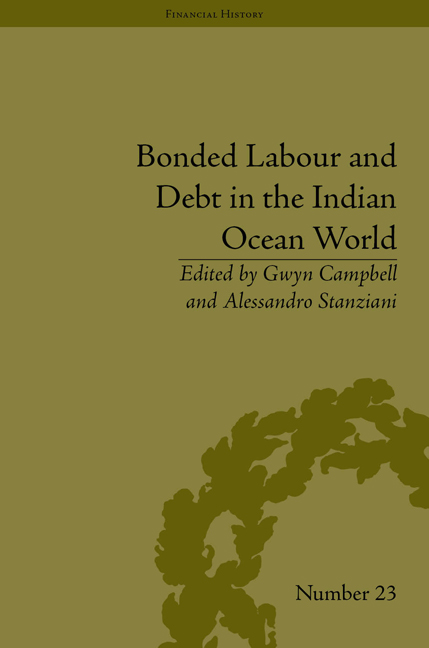Book contents
- Frontmatter
- Contents
- Acknowledgements
- List of Contributors
- Introduction
- 1 Debt and the Coercion of Labour in the Islamic Legal Tradition
- 2 Debt, Pawnship and Slavery in Nineteenth-Century East Africa
- 3 Debt and Slavery in Imperial Madagascar, 1790–1861
- 4 Credit and Debt in the Lives of Freed Slaves at the Cape of Good Hope: The Case of Arnoldus Koevoet, 1697–1735
- 5 Debt, Labour and Bondage: English Servants versus Indentured Immigrants in Mauritius, from the Late Eighteenth to Early Twentieth Century
- 6 Ransom, Escape and Debt Repayment in the Sulu Zone, 1750–1898
- 7 Debt and Slavery among Arabian Gulf Pearl Divers
- 8 The Political Economy of Debt Bondage in Contemporary South India
- 9 The Name of the Slave and the Quality of the Debt: When Slaves Are Not Debtors and Debtors Are Not Slaves in the Family Narrative of a Filipina Comfort Woman
- 10 Two Bonded Labour Emigration Patterns in Mid-Nineteenth-Century Southern China: The Coolie Trade and Emigration to Southeast Asia
- 11 Debt Slaves in Old Korea
- 12 The Debt-Servitude of Prostitutes in Japan during the Edo Period, 1600–1868
- Notes
- Index
12 - The Debt-Servitude of Prostitutes in Japan during the Edo Period, 1600–1868
- Frontmatter
- Contents
- Acknowledgements
- List of Contributors
- Introduction
- 1 Debt and the Coercion of Labour in the Islamic Legal Tradition
- 2 Debt, Pawnship and Slavery in Nineteenth-Century East Africa
- 3 Debt and Slavery in Imperial Madagascar, 1790–1861
- 4 Credit and Debt in the Lives of Freed Slaves at the Cape of Good Hope: The Case of Arnoldus Koevoet, 1697–1735
- 5 Debt, Labour and Bondage: English Servants versus Indentured Immigrants in Mauritius, from the Late Eighteenth to Early Twentieth Century
- 6 Ransom, Escape and Debt Repayment in the Sulu Zone, 1750–1898
- 7 Debt and Slavery among Arabian Gulf Pearl Divers
- 8 The Political Economy of Debt Bondage in Contemporary South India
- 9 The Name of the Slave and the Quality of the Debt: When Slaves Are Not Debtors and Debtors Are Not Slaves in the Family Narrative of a Filipina Comfort Woman
- 10 Two Bonded Labour Emigration Patterns in Mid-Nineteenth-Century Southern China: The Coolie Trade and Emigration to Southeast Asia
- 11 Debt Slaves in Old Korea
- 12 The Debt-Servitude of Prostitutes in Japan during the Edo Period, 1600–1868
- Notes
- Index
Summary
Introduction
During the Edo period (1600–1868), the trade in human beings was totally banned in Japan and gradually disappeared. Thus, those who had to work to repay their debts became indentured servants for only a specific period of time. However, the contracts of prostitutes persisted in keeping them in slave-like conditions. Most of the girls who belonged to licensed or unlicensed brothels in this period had been sold as apprentices by their parents or relatives and were subsequently forced to work as prostitutes in order to repay the advances their parents received as payment for their ‘apprenticeship’.
In this chapter I will first provide a general overview of human trafficking and the custom of debt servitude throughout Japanese history, as well as the history of prostitution in the Edo period. Then I will shift my focus to the prostitutes of the licensed brothels in the port city Nagasaki, which was the only city in which foreign trade with the Chinese and the Dutch was conducted. I will examine their contracts, working conditions and lives, as well as the social structure in which this system was approved.
‘The Trade in Human Beings’ throughout Japanese History
In Japan, human trafficking has generally been prohibited since antiquity. However, this does not mean that such trade did not exist. Under the ancient ritsuryō legal system, persons of the lowest social strata, who could be considered slaves, could in fact be bought and sold.
- Type
- Chapter
- Information
- Bonded Labour and Debt in the Indian Ocean World , pp. 173 - 186Publisher: Pickering & ChattoFirst published in: 2014

